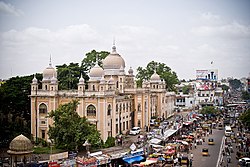| Government Nizamia General Hospital (حکومت نظامیہ جنرل ہسپتال ( طبی داواکہان | |
|---|---|
| Government of Telangana | |
 | |
 | |
| Geography | |
| Location | Charminar, Hyderabad, Telangana, India, 500002 |
| Coordinates | 17°21′38″N78°28′30″E / 17.3605319°N 78.4750474°E |
| Services | |
| Emergency department | No |
| Beds | 180 |
| History | |
| Opened | 1938 |
Government Nizamia General Hospital, popularly known as Government Unani Hospital, is a public hospital located in Hyderabad, Telangana, India. It is a hospital for general and Unani medicine. It was established during the reign of Nizams. It is located near the historic building of Charminar. [1]




